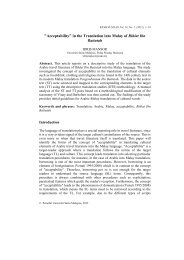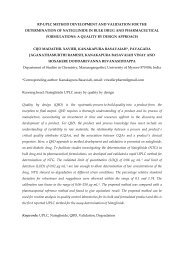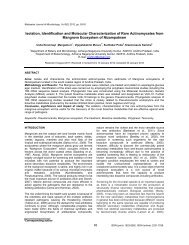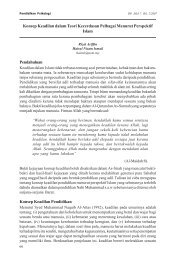Full Text - USM
Full Text - USM
Full Text - USM
Create successful ePaper yourself
Turn your PDF publications into a flip-book with our unique Google optimized e-Paper software.
Sylvia Constantinides<br />
Constantinides, S. (2001). Going-concern assessments for financially distressed firms:<br />
Factors influencing the quality of the judgement of auditors, bankers and insolvency<br />
practitioners (pp. 326–345). 1 st EARNet Convention, Germany.<br />
. (2002). Auditors', bankers' and insolvency practitioners' "going-concern"<br />
opinion logit model. Managerial Auditing Journal, 17(8), 487–501.<br />
Davis , R., Ricchiute, N., & Trompeter, G. (1993). Audit effort, audit fees and the<br />
provision of non-audit services to audit clients. The Accounting Review, 68(1),<br />
January, 135–150.<br />
Deshpande, R. (1983). Paradigms lost: On theory and method in research in marketing.<br />
Journal of Marketing, 47, Fall, 101–110.<br />
Eisenbeis , R. A. (1977). Pitfalls in the application of discriminant analysis in business<br />
finance and economics. Journal of Finance, 32(3), June, 875–899.<br />
Fishbein, M., & Ajzen, I. (1975). Belief, attitude, intention and behaviour. Reading,<br />
Mass: Addison-Wesley.<br />
Flynn, P. M., Leeth, J. D., & Levy, E. S. (1996). The evolving gender mix in accounting:<br />
implications for the future of the profession. Selections, Winter, 28–39.<br />
Furnham, A. (1992). Personality at work: The role of individual differences in the<br />
workplace. London: Routledge.<br />
Furnham, A., & Lewis , A. (1986). The economic mind: The social psychology economic<br />
behaviour. UK: Wheatsheaf Books Ltd.<br />
Grusd, N. (2006). Going, going, gone! The Secured Lender, 62(4), 62–64.<br />
Guiral, A., & Esteo, F. (2006). Are Spanish auditors skeptical in going concern<br />
evaluations? Managerial Auditing Journal, 21(6), 598–623.<br />
Hair, J. F. Jr., Anderson, R. E., Tatham, R. L., & Black, W. C. (1995). Multivariate data<br />
analysis. USA: Prentice-Hall Inc.<br />
Hopwood, W., McKeown, J. C., & Mutchler, J. F. (1994). A re-examination of auditor<br />
versus model accuracy within the context of the going-concern opinion decis ion.<br />
Contemporary Accounting Research, 10(2), 409–431.<br />
Huan, D. H. (1989). Audit considerations in assessing the application of the going<br />
concern concept. Doctoral dissertation, University of Manchester.<br />
Jensen, M. C., & Meckling, W. H. (1976). Theory of the firm: Managerial behaviour,<br />
agency costs and ownership structure. Journal of Financial Economics, 3, 305–360.<br />
Kalafatis , S. P., & Blankson, C. (1996). An investigation into the effect of questionnaire<br />
identification numbers in consumer mail surveys. Journal of the Market Research<br />
Society, 38(3), 277–284.<br />
Kalton, G. (1983). Introduction to survey sampling. USA: Sage Publications Inc.<br />
Kausar, A., Taffler, R. J., & Tan, C. E. L. (2006). The impact of bankruptcy code on the<br />
value of the auditor's going-concern opinion to investors (Working paper). UK:<br />
University of Edinburgh.<br />
Kennedy, D. B., & Shaw, W. H. (1991). Evaluating financial distress resolution using<br />
prior audit opinions. Contemporary Accounting Research, 8(1), 97–114.<br />
Kida, T. (1980). An investigation into auditors' continuity and related qualification<br />
judgments. Journal of Accounting Research, Autumn , 506–523.<br />
Kline, P. (1993). The handbook of psychological testing. London: Routledge.<br />
Koh, H. C. (2004). Going concern prediction using data mining techniques. Managerial<br />
Auditing Journal, 19(3), 462.<br />
48


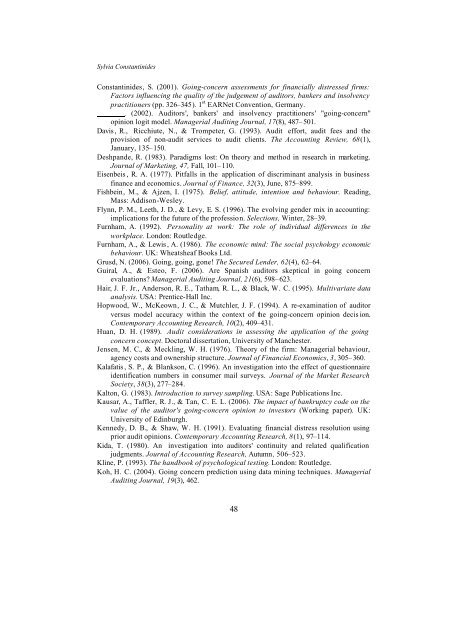
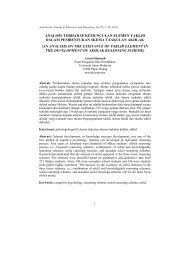
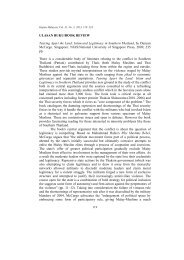

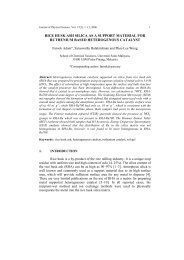

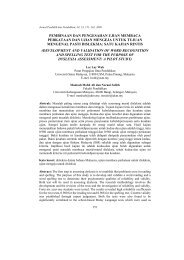
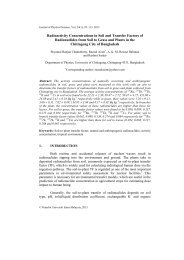
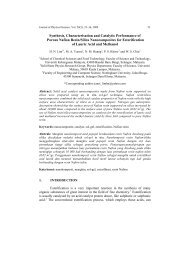

![KTT 111 – Inorganic Chemistry I [Kimia Takorganik I] - USM](https://img.yumpu.com/12405642/1/184x260/ktt-111-inorganic-chemistry-i-kimia-takorganik-i-usm.jpg?quality=85)
